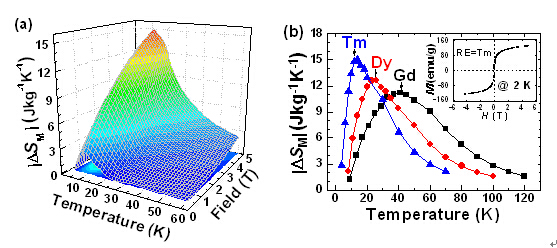
Compared with conventional gas refrigerants, the magnetic refrigerants based on the magnetocaloric effect (MCE) have advantages of both high efficiency and environmentally friendly. In the past decades, extensive efforts have been carried out in exploring the materials with excellent MCE, such as Gd5Si2Ge2, LaFe11.4Si1.6, etc., However, these crystalline materials usually show a narrow and large peak of isothermal magnetic entropy change (ΔSM)due to their abrupt first-order magneto-structural phase transition.
Metallic glasses, as a kind of second-order magnetic phase transition materials, manifest large MCE over a much wider temperature range owing to their intrinsic amorphous nature. The other advanced properties of metallic glasses, such as the high electrical resistivity, the small eddy current heating, high corrosion resistance, outstanding mechanical properties, and high thermally stability, are also preferred to the application as magnetic refrigerants. But up to now, only few metallic glasses with large ΔSM and refrigerant capacity (RC) have been fabricated. Exploring new BMGs with large ΔSM and RC is particularly important to improve the efficiency of refrigerant.
Recently, Dr. HUO Juntao et. al. in the group of amorphous soft magnetic materials in Ningbo Institute of Materials Technology and Engineering (NIMTE) has developed a series of high-entropy bulk metallic glasses (HE-BMGs) which based on the traditional RE-based BMGs. The metallic glasses have large MCE.
Different from the conventional BMGs that are usually composed of one or two major elements, the HE-BMGs are composed of several elements with equal concentration and large structural entropy. The HE-BMGs possess both strong topological and chemical disorder. Comparing with the ordinary BMGs and high-entropy alloys, the HE-BMGs have shown some unique and remarkably improved properties.The ΔSM and RC can reach 15.0 J kg-1 K-1 and 627 J kg-1 at 5 T, respectively, which are much larger compared to the ordinary rare earth-based BMGs. In addition, the magnetic ordering temperature, 〖∆S〗_M^pk and RC can be widely tuned by alloying different rare earth elements. These results suggest that the HE-BMGs are promising candidates as magnetic refrigerant.
The results have been published on Intermetallics, 2015 (58): 31-35 and Journal of Applied Physics, 2015 (117): 073902. This work was supported by the National Natural Science Foundation of China (Grant No. 51301188), the Ningbo Municipal Nature Science Foundation (Grant No. 2014A610165), and the China Postdoctoral Science Foundation (Grant No. 2013M541804).

Figure 1. (a) 3-dimentional magnetic entropy changes as a function of the temperature and applied magnetic field for Ho20Er20Co20Al20Tm20 HE-BMG. (b) Magnetic entropy changes as a function of temperature under 5 T for Ho20Er20Co20Al20RE20 (RE= Gd, Dy and Tm) HE-BMGs. The inset presents the magnetic hysteres is of Ho20Er20Co20Al20Tm20 HE-BMG.
All Images by ![]()

86-10-68597521 (day)
86-10-68597289 (night)

52 Sanlihe Rd., Xicheng District,
Beijing, China (100864)

